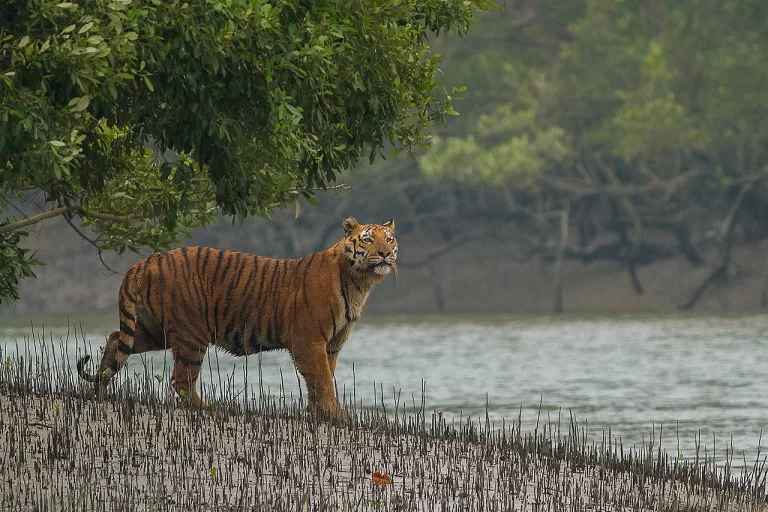Barely a few hours away from the hustle and bustle of Kolkata, the pulsating heart of West Bengal, lies a world that is starkly different yet mesmerizing in its own unique way – the Sundarbans.
Stretching across the southern deltaic regions of West Bengal in India and Bangladesh, the Sundarbans is the world’s largest mangrove forest and a UNESCO World Heritage Site.
It is a labyrinth of tidal waterways, mudflats, and small islands teeming with an incredible diversity of flora and fauna.
Table of Contents
A Unique Ecosystem
The uniqueness of the Sundarbans lies in its mangrove ecosystem.
The salt-tolerant mangrove trees, with their thick roots arching above the water level, form a fascinating natural spectacle and a protective barrier against cyclones and tidal surges.
This dense vegetation is home to a myriad of creatures, both large and small, each adapting to the challenging tidal rhythms and saline environment.
Royal Bengal Tigers
The Sundarbans is perhaps best known for its population of Royal Bengal Tigers.
These elusive creatures have adapted to the mangrove environment, with many becoming adept swimmers.
It’s important to note that spotting a tiger is more a matter of luck given the dense vegetation and the animals’ elusive nature. However, the mere possibility adds an exciting edge to every journey through the Sundarbans.
Rich Wildlife
Apart from the Bengal Tigers, the Sundarbans is a haven for wildlife enthusiasts and bird watchers.
The region is home to a variety of species like the spotted deer, saltwater crocodile, Gangetic dolphin, and king cobra.
Additionally, migratory birds flock to these parts during winter, transforming the area into a bird watcher’s paradise.
Village Tours and Local Culture
Experiencing the Sundarbans is not just about wildlife; it’s also about understanding the local culture and way of life.
Many tour operators offer guided village walks where you can interact with locals, sample traditional Bengali cuisine, and learn about their unique relationship with this challenging ecosystem.

Cruising Through the Sundarbans
The best way to explore the Sundarbans is by boat. Several tour operators offer multi-day cruises that navigate through the maze of waterways.
These journeys offer ample opportunities for wildlife spotting, photography, and simply soaking in the tranquil beauty of this unique landscape.
Best Time to Visit
The best time to visit the Sundarbans is between November and February when the weather is pleasant, and it’s the perfect time for bird watching.
Exploring the Sundarbans is like stepping into a nature documentary, where every turn reveals a new wonder and the lines between man and wild blur.
It’s an experience that stays with you long after you’ve left, reminding you of the untamed beauty that lies in this mangrove haven.
(FAQs) about the Sundarbans:
- Q: What are the Sundarbans?
- A: The Sundarbans is a vast mangrove forest delta located in the southern part of Bangladesh and the eastern part of India. It is known for its unique ecosystem and biodiversity.
- Q: Why is it called the Sundarbans?
- A: The name “Sundarbans” is derived from the Sundari trees (Heritiera fomes), which are prevalent in the region. The word “Sundar” means beautiful, reflecting the scenic landscape of the area.
- Q: What is the significance of the Sundarbans?
- A: The Sundarbans is a UNESCO World Heritage Site and a Biosphere Reserve, recognized for its critical role in supporting diverse flora and fauna, including the Bengal tiger. It also acts as a natural barrier against cyclones and tidal surges.
- Q: How large is the Sundarbans area?
- A: The Sundarbans covers an area of approximately 10,000 square kilometers, extending across both Bangladesh and India.
- Q: What is unique about the Sundarbans ecosystem?
- A: The Sundarbans is the largest mangrove forest in the world, characterized by a complex network of tidal waterways, small islands, and mudflats. It is home to a variety of plant and animal species adapted to the brackish water environment.
- Q: What wildlife can be found in the Sundarbans?
- A: The Sundarbans is home to diverse wildlife, including the Bengal tiger, spotted deer, crocodiles, various species of fish, and a wide array of bird species. It is also a critical habitat for the endangered Irrawaddy dolphins.
- Q: Can tourists visit the Sundarbans?
- A: Yes, tourists can visit the Sundarbans, but access is regulated to minimize environmental impact. There are guided boat tours that allow visitors to explore the mangrove forests, observe wildlife, and appreciate the natural beauty of the area.
- Q: How do people living in the Sundarbans region sustain themselves?
- A: The residents of the Sundarbans region often rely on fishing, honey collection, and traditional agriculture for their livelihoods. However, they face challenges such as the impact of climate change and the risk of encounters with wildlife.
- Q: Is the Sundarbans affected by climate change?
- A: Yes, the Sundarbans are vulnerable to the impacts of climate change, including rising sea levels and extreme weather events. This poses a threat to both the ecosystem and the communities living in the region.
- Q: How can the Sundarbans be protected?
- A: Conservation efforts involve sustainable management practices, community engagement, and international cooperation. Efforts are focused on preserving the biodiversity, protecting the habitat of the Bengal tiger, and ensuring the well-being of the local communities.
These FAQs provide a brief overview of the Sundarbans, covering its ecological importance, wildlife, tourism, and the challenges it faces.


